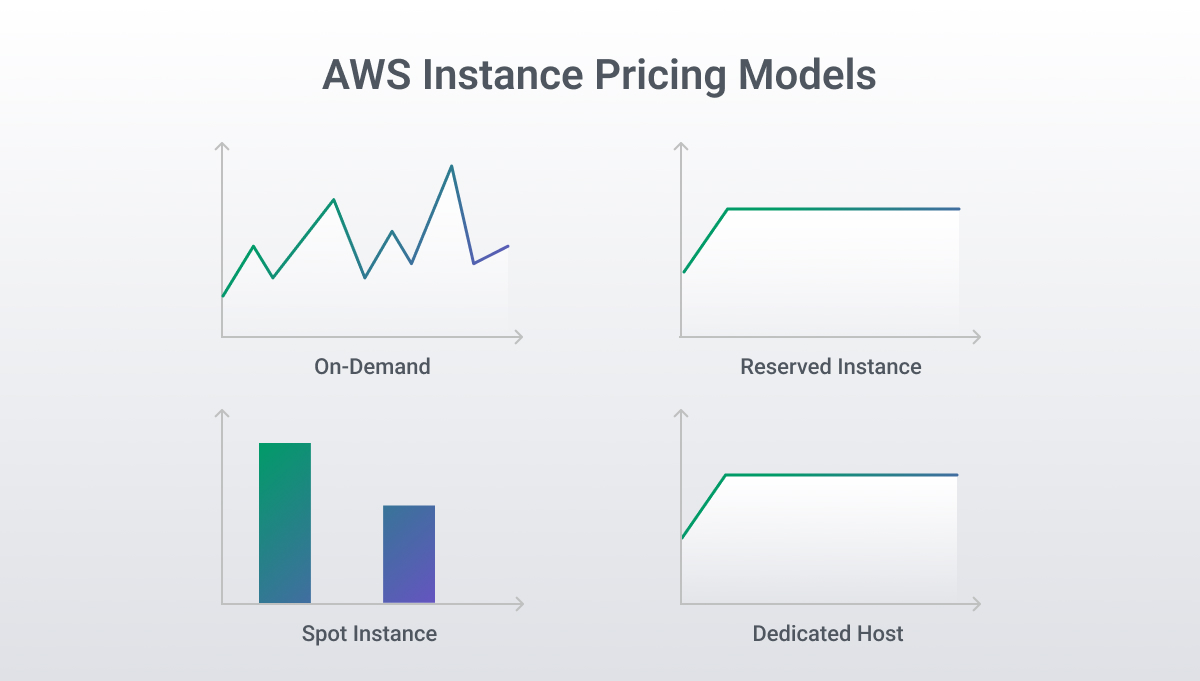As the cloud computing arm of Amazon, AWS (Amazon Web Services) offers an extensive array of infrastructure services to companies of all sizes, across the globe. While AWS provides flexibility, scalability, and efficiency, managing costs effectively remains a challenge for many.
Without proper oversight, expenses can quickly spiral out of control. This article aims to equip you with strategic tips for AWS cost optimization, drawing from real-world experiences and insights from DevOps professionals at Softjourn.
Understanding AWS Pricing
Understanding AWS's pricing model is crucial to optimizing costs. AWS offers several pricing options, including On-Demand, Reserved Instances, and Spot Instances, each catering to different use cases and budgetary constraints. Familiarizing yourself with the AWS billing dashboard and utilizing cost allocation tags can help in tracking and managing expenses more efficiently.
To further empower your journey towards efficient AWS cost management, we recommend exploring the AWS Pricing Calculator. This tool allows you to estimate your monthly AWS bill by configuring services according to your projected usage.

Tip 1: Right-Size Your Services and Clean Up Unnecessary Resources
"Monitoring current server performance regularly allows us to adjust capacities effectively," shares Artem Mytnuk, a DevOps engineer at Softjourn. He emphasizes the importance of right-sizing AWS resources to match your actual usage, rather than over-provisioning. This involves analyzing performance metrics to identify and eliminate underutilized or oversized instances, which can lead to significant cost savings.
Beyond adjusting your service capacities to fit your current needs, we also recommend proactively identifying and terminating any EC2 instances that are no longer in use. By doing so, you're not only right-sizing but also cleaning up unnecessary resources, which can lead to substantial cost savings. This holistic approach to resource management ensures you're optimizing for both efficiency and cost-effectiveness.
Tip 2: Utilize Reserved and Spot Instances
If you haven’t considered the cost-saving potential of Reserved and Spot Instances, now’s the time! By committing to Reserved Instances for predictable workloads, you can enjoy a lower rate compared to On-Demand pricing, while Spot Instances can be leveraged for flexible, non-critical applications at a fraction of the cost.
"We've successfully reduced AWS expenses by over three times for our client, Ukrainian Processing Center, by strategically using Spot Instances," Artem notes, showcasing the effectiveness of this approach.

Tip 3: Optimize Data Transfer Costs and Select Availability Zones and Regions
Data transfer fees can add up quickly on AWS. To minimize these costs, consider strategies such as selecting the right AWS region to reduce cross-region data transfer charges and using Amazon CloudFront for content delivery. This can significantly reduce the amount of data transferred from AWS and, consequently, the associated costs.
Recent developments have further improved AWS's approach to managing data transfer costs. Following regulatory pressures and Google’s strategic move, AWS has announced that it will allow customers to transfer their data out of its ecosystem without incurring any egress fees, applying globally. This change aims to facilitate easier switching between cloud providers or adopting a multi-cloud strategy, enhancing flexibility and potentially reducing costs further.
Tip 4: Implement Auto-Scaling
At Softjourn, our DevOps engineers find Auto-scaling a game-changer for reducing AWS expenses. It allows you to automatically adjust your resources based on demand, ensuring that you only pay for what you need. This can be particularly useful for applications with variable workloads, helping to eliminate wasteful spending on idle resources.
Tip 5: Monitor and Track Costs Regularly
Wallace Lima, a seasoned DevOps Engineer at Softjourn, stresses the importance of utilizing AWS's native logs and metrics for cost optimization. "Starting with native logs and metrics allows us to build a benchmark and move forward efficiently," he explains.
Regularly monitoring and tracking your AWS spending using tools like AWS Cost Explorer and setting up alerts for budget thresholds can help in identifying and addressing inefficiencies promptly.
Tip 6: Leverage AWS Cost Management Tools
At Softjourn, our experienced DevOps teams make full use of the cost management tools provided by AWS, such as the AWS Trusted Advisor and AWS Cost and Usage Report, a cost optimization hub. These tools can help identify unused or idle resources, recommend reserved instance purchases, and highlight opportunities for cost optimization.

Tip 7: Plan for AWS Savings with Commitment Discounts
Committing to one or three-year terms for specific services can unlock substantial savings over the standard on-demand pricing. This strategy involves evaluating your long-term resource needs and leveraging Reserved Instances or Savings Plans for services such as EC2, RDS, and Fargate.
By committing, you can enjoy discounts that significantly reduce your overall cloud expenditure. This approach is ideal for workloads with predictable usage patterns, enabling you to plan your costs more effectively while securing lower rates.
Tip 8: Consider Storage Access Needs
Managing operational data effectively is crucial for balancing storage costs and compliance needs. Maksym Lushpenko, DevOps expert at Brokee, recommends beginning this by determining the scope of data you need to monitor and retain—this includes logs, files, transactions, and other records. “Your decision should be guided by regulatory requirements and your company's specific operational needs,” he says. Once you've defined what's essential, consider archiving older data to a more cost-effective storage solution. This approach not only optimizes your storage costs but also ensures that you maintain ready access to the most relevant data.
Additionally, storage costs can accumulate unnoticed, making it essential to regularly audit your storage utilization. We suggest identifying Amazon EBS volumes with low activity and then deleting the original volumes to avoid unnecessary storage charges. Utilizing tools like AWS Trusted Advisor can help in identifying these underutilized volumes, while Amazon Data Lifecycle Manager automates the snapshot process. This proactive management of storage resources ensures you're only paying for what you need, contributing to a more cost-effective AWS environment.
Case Studies: Reducing AWS Costs
Softjourn's DevOps team has consistently demonstrated its ability to implement cost-effective, efficient, and secure cloud solutions across a wide range of projects. Below, we highlight some of our most impactful collaborations, showcasing the tangible benefits our clients have experienced.
.jpg)
Softjourn's Strategic Interventions Save Over $25k Annually on AWS
Our collaboration with an expense management client is a testament to our commitment to cost optimization without compromising on system integrity or performance. By meticulously analyzing and optimizing their AWS infrastructure, we helped them achieve savings exceeding $25,000 annually. This success story underlines our proficiency in delivering value while ensuring operational excellence.
Cinewav: A Tale of Enhanced Performance and 30% Cost Reduction
Cinewav faced challenges with their cloud infrastructure that impacted their operational costs and system performance. Softjourn's cloud consultants embarked on a comprehensive optimization strategy, encompassing multi-regional deployment, CDN fine-tuning, server upscaling, and efficient resource allocation. Our efforts resulted in a 30% reduction in AWS costs, alongside significant performance improvements, demonstrating our capability to scale and secure client operations effectively.
Bullet’s Seamless Migration to AWS
We helped Bullet strategically select a migration to AWS in pursuit of becoming a Central Bank Regulated entity. Softjourn's DevOps team was instrumental in designing the architecture, managing the transition, and providing ongoing support. This seamless migration not only facilitated their regulatory compliance but also ensured they leveraged the best of AWS's capabilities.

Maximize AWS Savings and Efficiency With Softjourn
While the tips provided here lay a solid foundation for optimizing your AWS expenses, partnering with experts can elevate your cost-saving strategies to new heights. Softjourn offers specialized AWS consulting services, designed to help you unlock maximum value from your cloud investments.
Whether you're looking to refine your cloud infrastructure, implement effective cost management tools, or adopt a FinOps approach to cloud services, Softjourn is here to guide you every step of the way. Take the first step towards optimized cloud spending and enhanced operational efficiency. Contact Softjourn's team of experts today, and let us help you transform your AWS strategy into one that saves on costs and drives your business forward.











